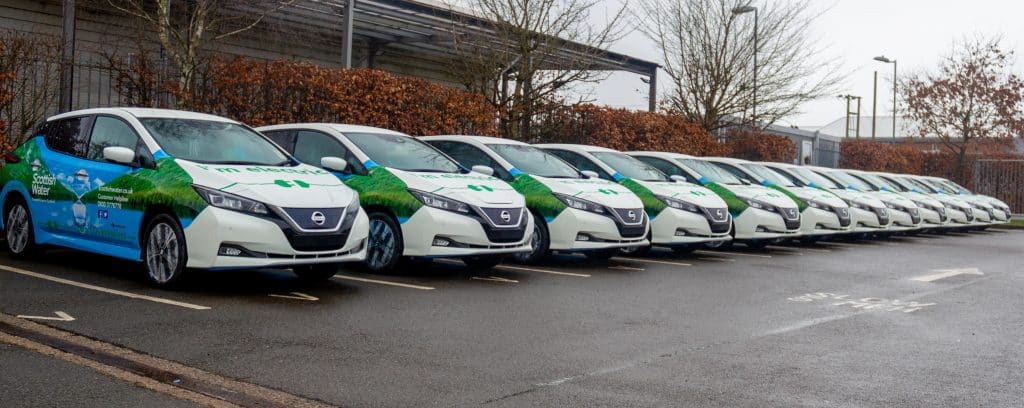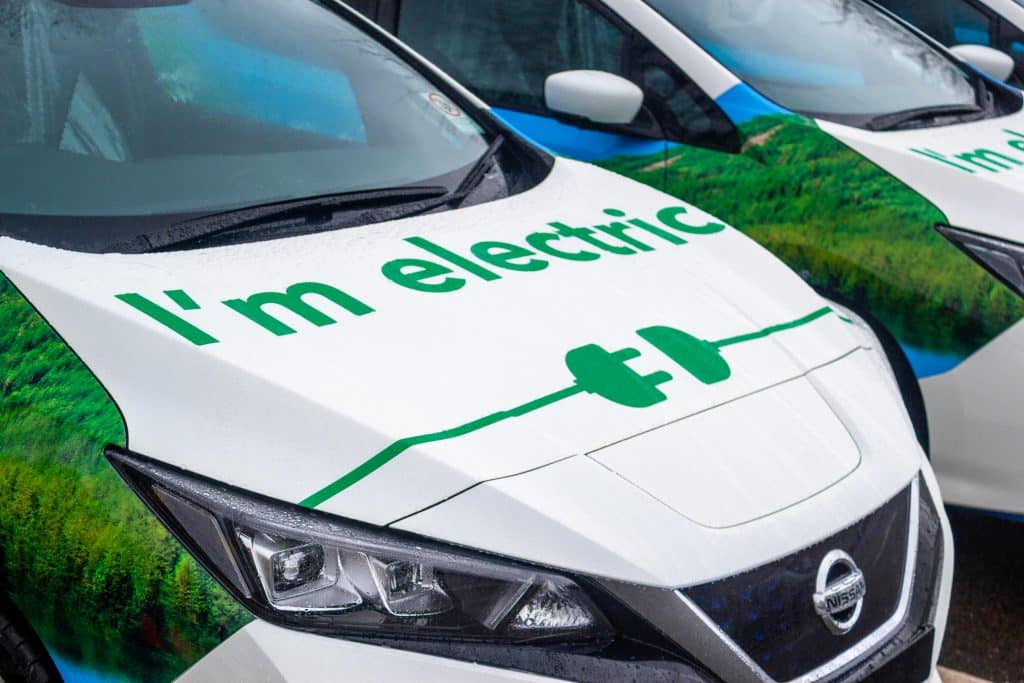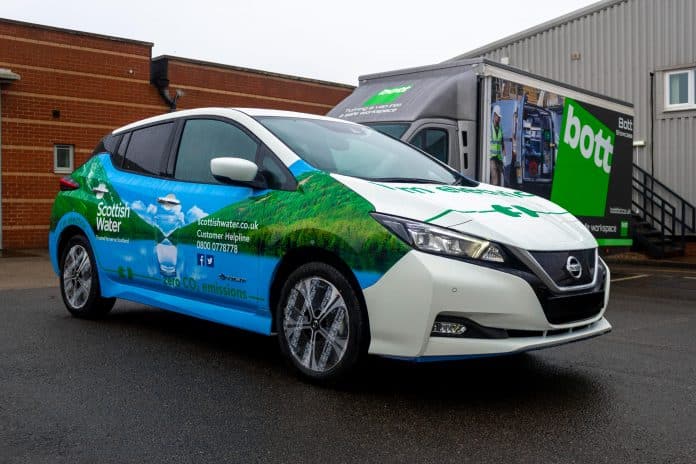Scottish Water is illustrating a real commitment to reducing the environmental impact of its fleet operations. Essential Fleet Operator caught up with their Fleet Manager Elaine Pringle, to further understand how the Scottish Water fleet, as a whole, can realistically transition to electric and zero emission alternatives and how her team manages operational road risk in a complex fleet.

Q: Could you describe your current fleet, breaking it down into LCVs, EVs, specialist vehicles, cars and grey fleet?
Scottish Water’s fleet is made up of 220 lease cars across our essential user and manager car schemes, 12 electric pool cars, 1,250 light commercial vehicles (LCVs), 120 heavy goods vehicles (HGVs) and 50 trailers and 500 items of plant, including small trailers, mini excavators and forklifts. The majority of our commercial vehicles are specialist, or have ancillary equipment fitted, such as tankers, jetting units, cranes, fridges etc.
In addition to our commercial fleet, we have c. 1,800 grey fleet drivers who normally drive on business journeys.
Q: What have been the key influences that have affected how your fleet has evolved during your time with Scottish Water?
Over the last 12 months, since taking on the fleet manager role, Scottish Water’s business travel environment has been affected by several factors and whilst the long-term impact of COVID is still unknown, others falling under the heading of climate change will still have a significant impact.
The Scottish Government’s Programme for Scotland, Protecting Scotland’s Future, sets an expectation for public sector fleets to phase out the need for: petrol and diesel cars by 2025; new petrol and diesel vans from 2025 and; new petrol and diesel commercial vehicles from 2030.
Q: In common with other operators of large, complex fleets, you are replacing traditionally powered vehicles with EVs. What are the factors that you consider before deciding which vehicles can be switched to electric?
We have already started to make positive changes across our car fleet:
-We have transitioned our pool cars to EVs
-We have introduced an EV only policy for new lease cars
-We are exploring opportunities to introduce a salary sacrifice scheme to make EVs accessible for all employees
For our commercial vehicles, Scottish Water plan to transition to electric vehicles (EVs) when it is economic and operationally practicable to do so.
Prior to replacing a fossil fuel vehicle with an EV, we will consider the total cost of ownership (TCO): whilst the purchase price of an EV is higher, this should be offset by reduction in fuel costs and we should expect to see payback within the asset life. In addition to cost, there are operational criteria that need to be considered to ensure minimal impact on service to our customers and our operational practices. This includes vehicle technology, such as range, payload, towing capability and compatibility with on-board equipment. We will also need to consider availability and provision of infrastructure and suppliers to service and maintain EVs.
Q: Are there other low or zero emission alternatives that you can look at for vehicles that cannot presently be switched to electric?
Based on these considerations, our planning assumptions are to replace our small and medium vans with EVs at the end of their life cycle. Whilst electric large van equivalents are available, it is not yet economic to transition due to the purchase price. We have explored use of fuel cell, hydrogen and gas vehicles – however there is still a lack of UK vehicle availability and infrastructure. We complete a regular market scan and test new options as they become available.
Q: You have committed to Net Zero by 2040. As well as this, what are the main objectives of your overall fleet strategy?
It’s an exciting time for us as we begin our transition to a zero-emission fleet and contribute towards Scottish Water’s journey to net zero emissions by 2040. In addition to the Scottish Government targets, Scottish Water have also set our own ambitious target to complete our transition to a zero-emission fleet by 2030.
Q: What are the challenges of a large home-based fleet, combined with grey fleet, when managing risk an what level of driver training are you using to minimise that risk?
Apart from our HGVs, the majority of our commercial vehicles go home overnight for business purposes, to allow our operational teams to respond to standby events or to benefit from efficiencies of direct to site working practices.
To manage our operational road risk, we undertake a number of driver safety activities, including driver induction and training, a scheduled of planned vehicle audits and unannounced gate checks and post incident investigation.
We complete driving licence checks for all our drivers and for our grey fleet drivers, this includes vehicle checks including tax, MOT and insurance.
Q: With the home-based vehicles in mind, how do you manage SMR schedules and therefore maximise efficiency and minimise vehicle downtime?
All our commercial vehicle drivers complete pre-use vehicle checks using a mobile phone app. The driver records any defects and is able to arrange repair via our outsourced maintenance suppliers. Scheduled maintenance is planned in advance and communicated to our operational teams in a forward maintenance planner. We have a network of garages and suppliers across Scotland to service our assets locally where possible.
Q: Are you able to offer home-based drivers charging solutions to enable the widespread adoption of EVs and what are the challenges with this?
We are still in the early stages of our transition to EVs and we are already beginning to trial some innovative technology that would allow employees to charge their van at home and Scottish Water be directly billed for the energy used. Not everyone has access to off-road parking, so the challenge will be to source other publicly available charging infrastructure or hopefully in the near future we will see more commercially available charging infrastructure available, such as the new electric car charging forecourt that has opened in Essex.
Q: Have the last months of the Covid crisis caused any significant changes to the way that you operate and has it in any way forced positive changes that you will retain throughout the future?
Scottish Water has continued to provide essential services throughout Covid and therefore, we have only seen a slight reduction in mileage across our commercial vehicles. As with many businesses during Covid, the majority of our office-based staff are now working from home, which has significantly reduced our grey fleet business journeys in particular, by around 80%. We do see this as a forced positive change, and we will look to develop strategies to mitigate travel post Covid.
Q: Are you working towards any accreditations and how do you see your role developing over the next few months and years?
We have always taken great pride in maintaining a good operator compliance risk score (OCRS). Over the next 12 months, I would like to see us working towards achieving DVSA Earned Recognition.
Over the next few years, I look forward to the challenge of transitioning to a zero-emission fleet. We still have a lot of planning and engagement to do before we start a large-scale transition and it will be a big step for us from where we currently are. We are in a position now where we can start to introduce EVs onto the fleet in a planned manner, before it becomes mandatory in 2025. For many, this may well be providing employees with their first experience of driving an EV and we want this to be a positive experience for all.





